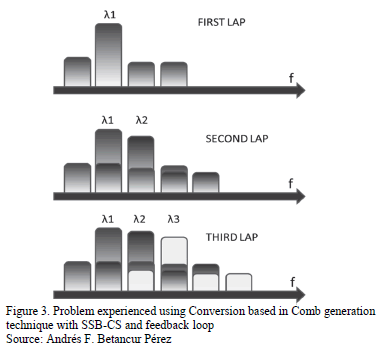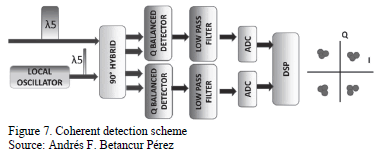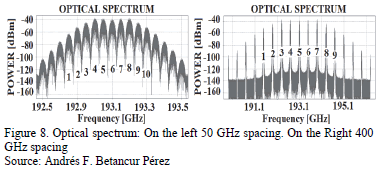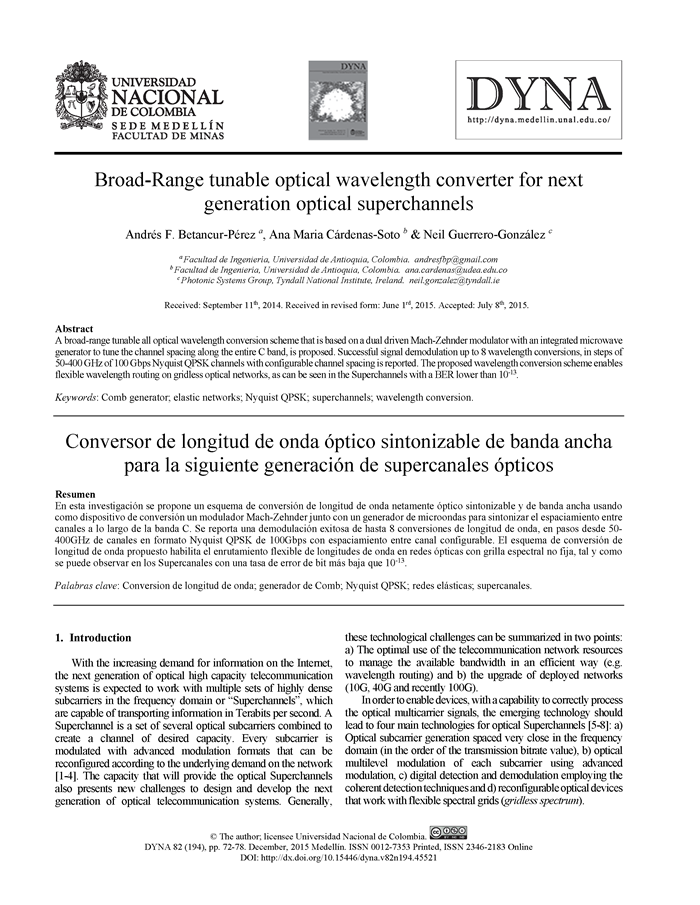
Publicado
Broad-Range tunable optical wavelength converter for next generation optical superchannels
DOI:
https://doi.org/10.15446/dyna.v82n194.45521Palabras clave:
Comb generator, elastic networks, Nyquist QPSK, superchannels, wavelength conversion. (es)Descargas
DOI: https://doi.org/10.15446/dyna.v82n194.45521
Broad-Range tunable optical wavelength converter for next generation optical superchannels
Conversor de longitud de onda óptico sintonizable de banda ancha para la siguiente generación de supercanales ópticos
Andrés F. Betancur-Pérez a, Ana Maria Cárdenas-Soto b & Neil Guerrero-González c
a Facultad de Ingeniería, Universidad de Antioquia, Colombia. andresfbp@gmail.com
b Facultad de Ingeniería, Universidad de Antioquia, Colombia. ana.cardenas@udea.edu.co
c Photonic Systems Group, Tyndall National
Institute, Ireland. neil.gonzalez@tyndall.ie
Received: September 11th, 2014. Received in revised form: June 1rd, 2015. Accepted: July 8th, 2015.
This work is licensed under a Creative Commons Attribution-NonCommercial-NoDerivatives 4.0 International License.
Abstract
A broad-range tunable
all optical wavelength conversion scheme that is based on a dual driven
Mach-Zehnder modulator with an integrated microwave generator to tune the
channel spacing along the entire C band, is proposed. Successful signal
demodulation up to 8 wavelength conversions, in steps of 50-400 GHz of 100 Gbps
Nyquist QPSK channels with configurable channel spacing is reported. The
proposed wavelength conversion scheme enables flexible wavelength routing on
gridless optical networks, as can be seen in the Superchannels with a BER lower
than 10-13.
Keywords: Comb generator; elastic networks; Nyquist QPSK; superchannels; wavelength conversion.
Resumen
En
esta investigación se propone un esquema de conversión de longitud de onda netamente
óptico sintonizable y de banda ancha usando como dispositivo de conversión un
modulador Mach-Zehnder junto con un generador de microondas para sintonizar el
espaciamiento entre canales a lo largo de la banda C. Se reporta una
demodulación exitosa de hasta 8 conversiones de longitud de onda, en pasos
desde 50-400GHz de canales en formato Nyquist QPSK de 100Gbps con espaciamiento
entre canal configurable. El esquema de conversión de longitud de onda
propuesto habilita el enrutamiento flexible de longitudes de onda en redes
ópticas con grilla espectral no fija, tal y como se puede observar en los
Supercanales con una tasa de error de bit más baja que 10-13.
Palabras clave: Conversion de longitud de onda; generador de Comb; Nyquist QPSK; redes elásticas; supercanales.
1. Introduction
With the increasing demand for information on the Internet, the next generation of optical high capacity telecommunication systems is expected to work with multiple sets of highly dense subcarriers in the frequency domain or "Superchannels", which are capable of transporting information in Terabits per second. A Superchannel is a set of several optical subcarriers combined to create a channel of desired capacity. Every subcarrier is modulated with advanced modulation formats that can be reconfigured according to the underlying demand on the network [1-4]. The capacity that will provide the optical Superchannels also presents new challenges to design and develop the next generation of optical telecommunication systems. Generally, these technological challenges can be summarized in two points: a) The optimal use of the telecommunication network resources to manage the available bandwidth in an efficient way (e.g. wavelength routing) and b) the upgrade of deployed networks (10G, 40G and recently 100G).
In order to enable devices, with a capability to correctly process the optical multicarrier signals, the emerging technology should lead to four main technologies for optical Superchannels [5-8]: a) Optical subcarrier generation spaced very close in the frequency domain (in the order of the transmission bitrate value), b) optical multilevel modulation of each subcarrier using advanced modulation, c) digital detection and demodulation employing the coherent detection techniques and d) reconfigurable optical devices that work with flexible spectral grids (gridless spectrum).
Among the optical devices that should be used for the Superchannels to function is the wavelength converter with the capability to work with a flexible spectral grid. This device is very important in making it possible for the wavelength to be reused and to prevent collisions among channels with common wavelengths. The wavelength converter should have the following characteristics: No modulation format dependence, C band operation, low signal distortion, low cost and processing must be all optical in order to decrease network latency. Several wavelength conversion techniques using SOAs (semiconductor optical amplifiers) and MZI (Mach-Zehnder Interferometer) have been demonstrated in the scientific literature [9-10], using intensity modulated signals with a 40Gbps bitrate. However, these techniques require continuous wave probe lasers to perform the conversion of each wavelength in the context of the Superchannels. On the other hand, the SOA by itself has a non-uniform gain and presents a polarization dependent gain, which results in an amplitude distortion of the pulses and Chirp, which limits the reach of the optical link. Nowadays, the wavelength conversion is performed before the modulation, obtaining the signal and using it to modulate the converted optical carrier provided by a tunable optical source (laser). This method of conversion requires optical-electrical-optical (OEO) transformations that add delays in the network and consume additional energy.
In this paper we propose a novel all-optical wavelength converter (AOWC) for advanced modulation signals along 32 nm of the C band. This proposed optical device is a critical component, which makes the easy reconfiguration of the optical network possible, taking into account the available resources such as bandwidth, wavelengths and routes. The presented wavelength converter avoids the need for OEO transformations and it can be employed as a subcarrier repeater (e.g. broadcast transmission). In order to configure the channel spacing, the proposed device makes use of a broad-range tunable microwave generator (TMWG) to change the spacing size. This TMWG has the advantage that, with only two optical sources, we can make a wavelength conversion for every optical subcarrier in the superchannel due to refractive index dependence with the electric field in the LiNbO3, which allows the same RF tone generated on parallel Mach Zehnder modulators to be used. In this paper, we demonstrate a wavelength converter that works with different channel spacing (until 400GHz) for Nyquist- Quadrature Phase Shift Keying (QPSK) () signals for 100Gbps (50GBaud/s) transmission rates with maximum degradations of the Bit Error Rate (BER) in the order of 10-10.
The working principle of the wavelength converter is presented in the first section of the paper. Later, the experimental setup and the simulation parameters are described in order to discuss the results analysis of the proposed wavelength converter, and, finally we present our conclusions. This proposed wavelength converter opens the doors to new flexible wavelength conversion techniques for the next generation of adaptive optical networks.
2. AOWC working principle
The proposed wavelength converter is based on the Optical Frequency Comb (OFC), a key system element, shown in Fig. 1. The OFC generation is designated in the literature as the optical mechanism that generates a set of carriers from only one laser with have characteristics such as: high coherence, low noise, stability, simple operation, and great spectral flatness (i.e. power fluctuations among optical subcarriers) [11]. The OFC output spectrum is a set of copies of the original modulated optical signal, but it is located in different wavelengths. The set of the modulated optical signals shifted in the wavelength domain, pass through a bandpass tunable optical filter that will allow the passage of the desired optical signal, as it is shown in Fig. 1. The result is the same input signal as the AOWC but it is located in the desired channel. The filtered optical signal is demodulated by the receiver by means of coherent detection, with an optical local oscillator tuned to the same wavelength as the converted signal.
Among the techniques used to generate multiple optical carriers from one single source are: The spectral slicing broadband light source [12], the FWM (Four Wave Mixing) technique [13,14], the ultrashort pulses generation technique [15] and the MZMs [16]. These techniques intend to reduce both the use of several optical sources in the telecommunication networks and reduce costs by using a single laser. The OFCG-MZM is attractive because it offers several characteristics described previously such as high coherence, stability, and simple operation. However, the characterization of the wavelength conversion of modulated optical signals based on MZMs has not been either proved or tested.
The OFCG with MZM, implemented according to Fig. 2a, obeys an electro-optic phase modulation with a RF tones, as can be seen in the equation 2. The expressions 1 and 2 show that the modulation index bi is adjusted if the amplitude of the RF signals (VRFi) are modified, and if the Vbiasi applied to the arms of the MZM is altered, the phase of each side band can be varied [17]. On the end side of the MZM, the spectrum of each arm is superposed and every side band is added constructively or destructively in certain quantity, depending on the phase of each side band. In this way, the spectral flatness can be improved if different amplitude and bias are applied to each arm of the MZM.
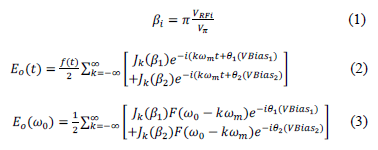
Where:
f(t): Input modulated optical signal with center frequency wc.
Vp: Induced voltage in which the phase of the optical electric field in the MZM reaches 180°.
wm: Angular frequency of the RF tone.
q1: Phase induced by the polarization on arm 1.
q2: Phase induced by the polarization on arm 2.
b1: Modulation Index related to RF tone amplitude on arm 1.
b2: Modulation Index related to RF tone amplitude on arm 2.
F(w): The Fourier transform of f(t).
k: Order of Bessel function
The Fourier transform in equation 2 can be appreciated in expression 3 where w0=w-wc. This equation shows that countless side bands are created according to the Bessel functions; however, the power decreases as the frequencies of the side bands go away from the central frequency.
There are several OFCG-MZM techniques with or without feedback, as can be seen in the Fig. 2 [17]. Fig. 2(a), 2(b), and 2(c) show some examples of open loop OFCG-MZM. In Fig. 2(a) a dual driven Comb generator (DD-MZM) is described and two Radio Frequency (RF) signals are used, the frequency of one being double that of the other. The phase and amplitude of the RF signals are different as is the bias of each arm of the MZM. In the Fig. 2(b), one similar configuration is appreciated with the difference being that each arm of the MZM is operated with two combined RF sinusoidal signals with frequencies of fo and 2fo. This method adds the diplexer device to generate the comb. In Fig. 2(c) the setup of two cascaded MZMs can be visualized. In this method, the operation of each MZM is carried out with the same RF frequency; however, each one is separately biased. The amplitude and the phase of the RF signals that are used to operate each MZM are different.
Moreover, there are techniques to generate combs with MZMs using fiber loops. One of them uses the same DD-MZM setup and a fiber loop with an optical amplifier (Fig. 2(d)), and the other technique (Fig. 2(e)) uses the same optical loop and two parallel MZMs configured to make SSB-CS modulation (Single Side Band Modulation with Carrier Suppression). These methods add more complexity but can create more optical carriers by taking the generated components to the MZMs' input and repeating the process. The new spectral components create more optical carriers, and in every lap the new components interfere with each other adding or subtracting the amplitude, depending on each spectral component phase [18,19].
An implementation based on feedback loop techniques presents impairments as interference among channels is caused by the fiber loop. This is because, in every lap, the signals have conversions that also generate new ones, due to the interference between the incoming signals and the previous ones. The interference is possible because the RF tone produces the same channel spacing between each spectral component, increasing the symbol error rate with the number of laps. Even if the SSB-SC is used, the same problem still exists as there is no total side band suppression or carrier suppression. Hence, side bands remain with enough power spectral density to be a considerable noise, just as is illustrated in Fig. 3.
The OFCG scheme used is the configuration that can be seen in Fig. 2a. It is used because of its simple operation, low complexity, and its cost effectiveness. The other configurations add more complexity and generate just one or two more subcarriers, which result in a non-reliable cost-benefit ratio.
In order to generate new wavelength conversions to cover most of the C band, it is desirable to generate high RF tone frequencies up until 400 GHz in order to create the same channel spacing value between conversions. According to the state of the art for electronics there is no shown capacity shown to generate such frequencies; consequently, another approach should be taken into account in order to overcome this limitation. The proposed model to generate frequencies higher than 100 GHz is based on the schemes used in radio over fiber (RoF) systems [20] to generate millimeter wave signals using two optical sources in which one of them is tunable and the other has a fixed frequency. With the quadratic characteristic of the photodetector we could generate RF tones with a frequency equal to the difference of the two optical source frequencies. In the next section, we demonstrate our technique to generate RF tones in the range of 10 GHz to 400 GHz.
3. AOWC model setup
In Fig. 4, the general scheme of the back-to-back implementation carried out using VPI simulation software can be seen. It can be divided in three stages: The DD-MZM, the tunable optical filter and the coherent receiver.
3.1. DD-MZM based converter
The proposed system is based on the MZM setup in dual drive operation that is shown in Fig. 5. It has equal RF operation frequencies in both arms and different amplitudes (0.5V and 1V) on each arm, the modulation indexes of which are different because each arm is biased in different operating points.
The optical source is a 193.1THz optical carrier, with 20mW of power that is modulated externally by Nyquist. Its pulses are generated with a raised cosine filter with a roll off factor equal to 1, it has a QPSK format and a 100 Gbps bit rate (50GBaud/s). The MZM has values of Vp y VRF equal to 1V [21] and an extinction ratio of 25dB. One arm of the MZM is operated with a RF tone with an amplitude equal to 0.5V and biased to 0.4V. The other arm is operated with an RF tone amplitude of 1V and biased with 0V. The RF tones are generated with a tunable microwave generator (TMWG).
The TMWG setup was configured according to the scheme illustrated in Fig. 6. The fixed Laser has a frequency of 193.1THz. Both lasers have linewidth of 1 KHz and a power of 20 mW to get a RF sine wave as pure as possible at the output of the TMWG. The optical carriers are injected to a coupler and the mixed wavelengths are detected by a photodiode APD with a 1A/W responsivity, 2nA dark current, 100 multiplicative factor, 1 ionization coefficient and a 10-12 A/Hz thermal noise of. The quadratic characteristic of the photodiode generates an electric current at a frequency equal to the difference between the frequencies of the optical sources. The detected electrical signal is filtered by a bandpass filter to reduce the noise, and it is then applied to the MZM. This method has great benefits such as: high integration (the AOWC can be made on a single chip), and it can be easily controlled by other systems with electric signals that can be useful in adaptive optical networks.
The MZM output signal is a set of channels where eight of them possess a low BER degradation and channel spacing equal to the generated frequency on the TMWG, as can be seen in the scheme illustrated in Fig. 5. Every channel has the same information as the original input signal.
3.2. Tunable Optical Filter
The optical signal is then filtered by a tunable bandpass Gaussian optical filter, the central frequency of which is tuned to the central frequency of each generated channel, allowing the wavelength conversion process. In our tests, the filter was tuned every 50 GHz and 400 GHz around the original channel (193.1THz) depending on the frequency spacing caused by the wavelength conversion process. The bandwidth of the filter is 0.9 fold the baudrate and it has a Gaussian order equal to 9 in order to obtain the desired channel. Nowadays, an optical filter that has tunable bandwidth and central frequency without deformation of its frequency response at speeds in the order of microseconds functions as the liquid crystal filter. At this rate, the wavelength conversion process is limited to offline applications.
3.3. Coherent Receiver
In Fig. 7, the scheme of the coherent receiver is illustrated. The signal is detected with a coherent receiver with a local oscillator tuned to the central frequency of each detected channel and with a power equal to 1mW. The photodetectors in the balanced detectors are PIN with a responsivity of 1A/W and thermal noise equal to 10-11 A/Hz. The lowpass electrical filter of the receiver has a Bessel transfer function of order 4, with a bandwidth of 0.75 fold the baudrate (37.5GHz). In the DSP (Digital Signal Processor) a BER estimation is performed assuming a Gaussian probability density function with a mean and variance equal to that of the signal samples. For such purpose, the logical channels are used to obtain the bit sequence sent by the transmitter.
4. Analysis of results
The spectrum obtained at the output of the AOWC is illustrated in Fig. 8. The tunable microwave generator was tuned to get a RF tone with frequencies of 50 GHz and 400 GHz in order to obtain the respective channel spacing. In this way, the location of the converted channels, according to the variable channel spacing suggested by the elastic optical networks (channel spacing, multiples of 12.5GHz), can be configured.
The minimum obtained BER (see Table 1) was in the order of 10-150 for the channel located on 193 THz. This corresponded to channel 4 for a 50GHz channel spacing; however, the BER was related to the variable power among the channels, the more power the converted signal, the less the BER. This is due to the optical signal power decreasing when the digital signal is phase modulated and because the power of each channel follows the pattern imposed by the Bessel functions inducing intensity variations compared with the original signal. The power variations on every converted channel must be equalized and amplified in order to level all the Superchannels at the output. The advantage of the Nyquist pulse format is its reduced spectrum compared to the pulses with NRZ (Non Return to Zero) format [22]. Moreover, Nyquist pulses belong to the Superchannel systems because it is desired that every subcarrier is tightly separated with a minimum channel spacing equal to the bit rate. In each spectrum, the peak power reduction of each channel with respect to the average input power (20dBm) can be seen; this effect is caused by the power distribution of the main optical channel among the generated side bands. This is a product of the OFCG modulation process, which gives multiple converted frequency options. Table 1 contains a summary of the BER for every converted channel option of the AOWC that was implemented. The BER of the channel 10 for 50GHz channel spacing is the biggest, but it may be recovered with FEC techniques after propagation through optical fiber in an adaptive optical network.
The calculated constellation diagrams in the coherent receiver output can be seen in Fig. 9. How the acquired points deviate around the original decision point is shown on the left. The standard deviation is greater in 194.7THz than in the original operation frequency (i.e. 193.1THz) because the OSNR (Optical Signal to Noise Ratio) is reduced in this channel.
To visualize the wavelength conversion effect over the QPSK signal, Fig. 10 illustrates the optical eye diagram of the AOWC input signal and the optical eye diagram of channel 9 (194.7THz) when a 400 GHz RF tone is used. The result when there is a wavelength conversion by means MZM is reduced power on each channel compared to the input signal. This effect impacts the eye pattern, closing it. However, the information on the phase transitions can still be detected as the wavelength converter is transparent to this modulation format.
5. Conclusions
A method for wavelength conversion without OEO transformations that is based on the MZM comb generation scheme without feedback was presented. Eight copies or subchannels were generated and spaced according to the tunable microwave tone generator, with the same as the original modulated optical signal as a central frequency value. The BER was reduced as low as 10-150 (error free), and this is due to the low noise present in the simulated back-to-back system. However, to evade a link that is limited by transmission power or attenuation, the processed optical signal in the wavelength converter must be amplified and equalized to get enough power and a flat spectrum in order to launch the optical subcarriers over the optical link or lightpath.
A satisfactory demodulation scheme for each one of the converted optical signals in the spectrum was presented, demonstrating a good performance of the proposed converter. Covering almost the entire C band of the standard single mode fiber was possible thanks to the tunable microwave generator that can generate RF tones until 400GHz. This functional block has the advantage of being integrated in a single photonic chip. This conversion has the characteristic of being transparent to the Nyquist QPSK modulation format. The method for wavelength conversion of modulated optical signals opens doors to photonic routing research for future elastic networks.
Acknowledgments
We would like to thank to Antioquia University, and specifically, the CODI (Comite para el Desarrollo de la Investigación), which supported us in our research project with code MDC 11-1-04. Sostenibilidad 2014 Project.
References
[1] Klekamp, A., Dischler, R. and Buchali, F., Limits of spectral efficiency and transmission reach of optical-OFDM superchannels for adaptive networks. IEEE Photonics Technology Letters, 23(20), pp. 1526-1528, 2011. DOI: 10.1109/LPT.2011.2161979
[2] Bosco, G., Curri, V., Carena, A., Poggiolini, P. and Forghieri, F., On the performance of nyquist-WDM terabit superchannels based on PM-BPSK, PM-QPSK, PM-8QAM or PM-16QAM subcarriers. Journal of Lightwave Technology, 29(1), pp. 53-61, 2011. DOI: 10.1109/JLT.2010.2091254
[3] INFINERA. Super-Channels DWDM transmission beyond 100Gb/s. White paper, [Online]. 2011. Available at: http://www.infinera.com/ pdfs/whitepapers
[4] Dischler, R., Buchali, F., Klekamp, A., Idler, W., Lach, E., Schippel, A., Schneiders, M., Vorbeck, S. and Braun, R.-P., Terabit transmission of high capacity multiband OFDM superchannels on field deployed single mode fiber, ECOC, pp. 1-3, 2010. DOI: 10.1109/ECOC.2010.5621258
[5] Tomkos, I., Palkopoulou, E. and Angelou, M., A survey of recent developments on flexible/elastic optical networking, 14th International Conference on Transparent Optical Networks (ICTON), 2012, pp. 1-6. DOI: 10.1109/ICTON.2012.6254409
[6] Colavolpe, G., Foggi, T., Forestieri, E. and Prati, G., Robust multilevel coherent optical systems with linear processing at the receiver. Journal of Lightwave Technology, 27(13), pp. 2357-2369, 2009. DOI: 10.1109/JLT.2008.2008821
[7] Van den Borne, D., Alfiad, M., Jansen, S.L. and Wuth, T., 40G/100G long-haul optical transmission system design using digital coherent receivers, 14th OptoElectronics and Communications Conference OECC, 2009, pp.1-2. DOI: 10.1109/OECC.2009.5214277
[8] Gerstel, O., Jinno, M., Lord, A. and Yoo, S.JB., Elastic optical networking: A new dawn for the optical layer?. Communications Magazine, IEEE, 50(2), pp. s12-s20, 2012. DOI: 10.1109/MCOM.2012.6146481
[9] Cao, B., Shea, D.P. and Mitchell, J.E., Wavelength converting optical access network for 10Gbit/s PON, 15th International Conference on Optical Network Design and Modeling (ONDM), 2011, pp. 1-6.
[10] Nguyen, A., Porzi, C., Pinna, S., Contestabile, G. and Bogoni, A., 40Gb/s all-optical selective wavelength shifter, Conference on Lasers and Electro-Optic (CLEO), 2011, pp. 1-2.
[11] Apex Technologies. Ultra high resolution OSA/OCSA for characterizing and evaluating optical frequency comb sources. White paper [Online]. 2013. Available at: http://www.apex-t.com/optical-frequency-comb/
[12] Pendock, G.J. and Sampson, D.D., Transmission performance of high bit rate spectrum-sliced WDM systems. Journal of Lightwave Technology, 14(10), pp. 2141-2148, 1996. DOI: 10.1109/50.541201
[13] Sefler, G.A. and Kitayama, K.-I., Frequency comb generation by four-wave mixing and the role of fiber dispersion. Journal of Lightwave Technology, 16(9), pp. 1596-1605, 1998. DOI: 10.1109/50.712242
[14] Takahashi, M., Hiroishi, J., Tadakuma, M. and Yagi, T., FWM wavelength conversion with over 60nm of 0dB conversion bandwidth by SBS-suppressed HNLF, Optical Fiber Communication Conference, 2009, pp. 1-3.
[15] Avrutin, E.A., Ryvkin, B.S., Kostamovaara, J. and Portnoi, E.L., Analysis of symmetric and asymmetric broadened-mode laser structures for short and ultrashort optical pulse generation, ICTON, 2010, pp. 1-4. DOI: 10.1109/ICTON.2010.5549074
[16] Mishra, A.K., Nellas, I., Tomkos, I., Koos, C., Freud, W. and Leuthold, J., Comb generator for 100Gbit/s OFDM and low-loss comb-line combiner using the optical inverse Fourier Transform (IFFT). ICTON, 2011, pp. 1-5. DOI: 10.1109/ ICTON.2011.5971034
[17] Puerto-Leguizamón, G.A., Suarez-Fajardo, C.A., Analytical model of signal generation for radio over fiber systems, DYNA, 81(188), pp. 26-33, 2014.
[18] Kawanishi, T., Sakamoto, T., Shinada, S. and Izutsu, M., Optical frequency comb generator using optical fiber loops with single-sideband modulation. IEICE Electronics Express, 1(8), pp. 217-221. DOI: 10.1587/elex.1.217
[19] Morohashi, I., Sakamoto, T., Yamamoto, N., Kawanishi, T., Hosako, I. and Sotobayashi, H., Broadening of comb bandwidth by multiple modulation using feedback loop in Mach-Zehnder-Modulator-Based flat comb generator, Microwave Photonics MWP IEEE Topical Meeting, 2010, pp. 220-223. DOI: 10.1109/MWP.2010.5664165
[20] Zhang, W. and Yao, J., Photonic generation of milimeter-wave signals with tunable phase shift. IEEE Photonics Journal, 4(3), pp. 889-894, 2012. DOI: 10.1109/MWP.2012.6474049
[21] Ding, J., Chen, H., Yang, L., Zhang, L., Ruiqiang, J., Tian, Y., Zhu, W., Lu, Y., Zhou, P. and Min, R., Low-voltage, high-extinction-ratio, Mach-Zehnder silicon optical modulator for CMOS-compatible integration. Optics Express, 20(3), pp. 3209-3218, 2012. DOI: 10.1364/OE.20.003209
[22] Torres-Nova, J. M. y Paz-Penagos, H., Estudio y comparación en eficiencia espectral y probabilidad de error de los esquemas de modulación GMSK y DBPSK, Ingeniería e Investigación, 28(3), pp. 75-80, 2008.
A.F. Betancur-Pérez, is Electronic Engineer from the Universidad de Antioquia, Colombia. He received his MSc in Telecommunications Engineering in 2014from the Universidad de Antioquia, Colombia. Currently, he is professor of telecommunications engineering and gives courses such as digital signal processing and optical communications, and is an associated researcher in the Instituto Tecnológico Metropolitano - ITM, Medellín, Colombia. ORCID: 0000-0002-4738-8052
A.M. Cárdenas-Soto, obtained her PhD. in 2003 from the Universidad Politécnica de Valencia, Spain. She worked in planning and design of telecommunication infrastructure in 1994-2005, at Empresas Públicas de Medellín - EPM, Medellín; Colombia, and as a professor in 2005-2009, at the Universidad Pontificia Bolivariana, Medellín, Colombia. She currently works at the Universidad de Antioquia, Medellín, Colombia. Her research interests are optical elastic networks and optical spectrum engineering. ORCID: 0000-0001-9152-8246
N. Guerrero-Gonzalez, is a postdoctoral researcher, has a BSc. Electronic Engineer degree in 2005 and a MSc. in industrial automation in 2007, both from the Universidad Nacional de Colombia, Medellín, Colombia. He completed his PhD. degree in Photonics Engineering in 2011, from the Technical University of Denmark (DTU). During March and August 2011, Neil was associated as a postdoctoral researcher to DTU - Fotonik under the FP7 European framework project CHRON. He has been also associated with Huawei Technologies (Munich, Germany) in 2012 as an optical engineer and with CPqD (Campinas, Brazil) between 2013 and 2014 as manager of the division of optical communication systems. Currently he is associated as a postdoctoral researcher to the Photonic Systems Group at Tyndall National Institute. His research interests include coherent optical communication, digital signal processing and hybrid fiber-wireless communication systems. ORCID: 0000-0002-8053-6280. ResearchID: E-7356-2015
Cómo citar
IEEE
ACM
ACS
APA
ABNT
Chicago
Harvard
MLA
Turabian
Vancouver
Descargar cita
Licencia
Derechos de autor 2015 DYNA

Esta obra está bajo una licencia internacional Creative Commons Atribución-NoComercial-SinDerivadas 4.0.
El autor o autores de un artículo aceptado para publicación en cualquiera de las revistas editadas por la facultad de Minas cederán la totalidad de los derechos patrimoniales a la Universidad Nacional de Colombia de manera gratuita, dentro de los cuáles se incluyen: el derecho a editar, publicar, reproducir y distribuir tanto en medios impresos como digitales, además de incluir en artículo en índices internacionales y/o bases de datos, de igual manera, se faculta a la editorial para utilizar las imágenes, tablas y/o cualquier material gráfico presentado en el artículo para el diseño de carátulas o posters de la misma revista.





